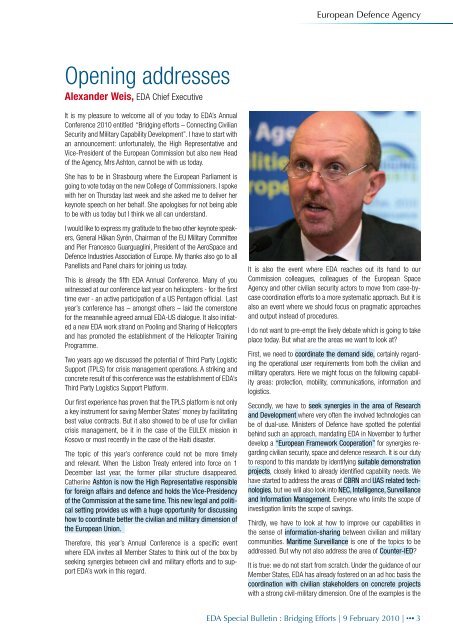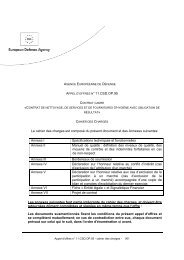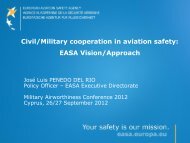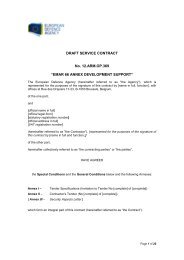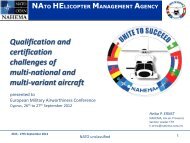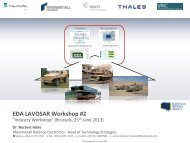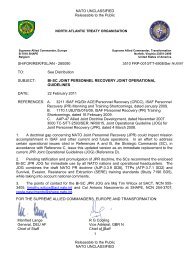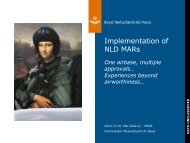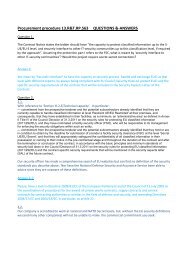Bulletin 14 - "Bridging Efforts" Special Bulletin - European Defence ...
Bulletin 14 - "Bridging Efforts" Special Bulletin - European Defence ...
Bulletin 14 - "Bridging Efforts" Special Bulletin - European Defence ...
Create successful ePaper yourself
Turn your PDF publications into a flip-book with our unique Google optimized e-Paper software.
Opening addresses<br />
Alexander Weis, EDA Chief Executive<br />
It is my pleasure to welcome all of you today to EDA’s Annual<br />
Conference 2010 entitled “<strong>Bridging</strong> efforts – Connecting Civilian<br />
Security and Military Capability Development”. I have to start with<br />
an announcement: unfortunately, the High Representative and<br />
Vice-President of the <strong>European</strong> Commission but also new Head<br />
of the Agency, Mrs Ashton, cannot be with us today.<br />
She has to be in Strasbourg where the <strong>European</strong> Parliament is<br />
going to vote today on the new College of Commissioners. I spoke<br />
with her on Thursday last week and she asked me to deliver her<br />
keynote speech on her behalf. She apologises for not being able<br />
to be with us today but I think we all can understand.<br />
I would like to express my gratitude to the two other keynote speakers,<br />
General Håkan Syrén, Chairman of the EU Military Committee<br />
and Pier Francesco Guarguaglini, President of the AeroSpace and<br />
<strong>Defence</strong> Industries Association of Europe. My thanks also go to all<br />
Panellists and Panel chairs for joining us today.<br />
This is already the fifth EDA Annual Conference. Many of you<br />
witnessed at our conference last year on helicopters - for the first<br />
time ever - an active participation of a US Pentagon official. Last<br />
year’s conference has – amongst others – laid the cornerstone<br />
for the meanwhile agreed annual EDA-US dialogue. It also initiated<br />
a new EDA work strand on Pooling and Sharing of Helicopters<br />
and has promoted the establishment of the Helicopter Training<br />
Programme.<br />
Two years ago we discussed the potential of Third Party Logistic<br />
Support (TPLS) for crisis management operations. A striking and<br />
concrete result of this conference was the establishment of EDA’s<br />
Third Party Logistics Support Platform.<br />
Our first experience has proven that the TPLS platform is not only<br />
a key instrument for saving Member States’ money by facilitating<br />
best value contracts. But it also showed to be of use for civilian<br />
crisis management, be it in the case of the EULEX mission in<br />
Kosovo or most recently in the case of the Haiti disaster.<br />
The topic of this year’s conference could not be more timely<br />
and relevant. When the Lisbon Treaty entered into force on 1<br />
December last year, the former pillar structure disappeared.<br />
Catherine Ashton is now the High Representative responsible<br />
for foreign affairs and defence and holds the Vice-Presidency<br />
of the Commission at the same time. This new legal and political<br />
setting provides us with a huge opportunity for discussing<br />
how to coordinate better the civilian and military dimension of<br />
the <strong>European</strong> Union.<br />
Therefore, this year’s Annual Conference is a specific event<br />
where EDA invites all Member States to think out of the box by<br />
seeking synergies between civil and military efforts and to support<br />
EDA’s work in this regard.<br />
It is also the event where EDA reaches out its hand to our<br />
Commission colleagues, colleagues of the <strong>European</strong> Space<br />
Agency and other civilian security actors to move from case-bycase<br />
coordination efforts to a more systematic approach. But it is<br />
also an event where we should focus on pragmatic approaches<br />
and output instead of procedures.<br />
I do not want to pre-empt the lively debate which is going to take<br />
place today. But what are the areas we want to look at?<br />
First, we need to coordinate the demand side, certainly regarding<br />
the operational user requirements from both the civilian and<br />
military operators. Here we might focus on the following capability<br />
areas: protection, mobility, communications, information and<br />
logistics.<br />
Secondly, we have to seek synergies in the area of Research<br />
and Development where very often the involved technologies can<br />
be of dual-use. Ministers of <strong>Defence</strong> have spotted the potential<br />
behind such an approach, mandating EDA in November to further<br />
develop a “<strong>European</strong> Framework Cooperation” for synergies regarding<br />
civilian security, space and defence research. It is our duty<br />
to respond to this mandate by identifying suitable demonstration<br />
projects, closely linked to already identified capability needs. We<br />
have started to address the areas of CBRN and UAS related technologies,<br />
but we will also look into NEC, Intelligence, Surveillance<br />
and Information Management. Everyone who limits the scope of<br />
investigation limits the scope of savings.<br />
Thirdly, we have to look at how to improve our capabilities in<br />
the sense of information-sharing between civilian and military<br />
communities. Maritime Surveillance is one of the topics to be<br />
addressed. But why not also address the area of Counter-IED?<br />
It is true: we do not start from scratch. Under the guidance of our<br />
Member States, EDA has already fostered on an ad hoc basis the<br />
coordination with civilian stakeholders on concrete projects<br />
with a strong civil-military dimension. One of the examples is the<br />
EDA <strong>Special</strong> <strong>Bulletin</strong> : <strong>Bridging</strong> Efforts | 9 February 2010 | 3


